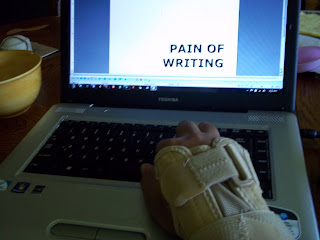The Pain of Writing and Chicano(a) Ergonomics
PART II
Simple changes can make writing less painful
 To read Part I of the The Pain of Writing, click HERE.
To read Part I of the The Pain of Writing, click HERE.As I write this, I burned my hand with olive oil while frying some tilapia, so I had to take a break from the blog.
You've read Part 1 of The Pain of Writing and you are feeling my pain. This post will talk about prevention and other things you can do to keep you arms and manitos in good health and condition.
Photo above, Ray's hand resulting from
playing with fire and burning bridges
Admit when you are tired
One of the main things you must keep mind is that when your hands and writs, and forearms, start to hurt while typing -- it is probably time to stop.
If you have trouble taking rests, or you are in the writing zone frequently (I know some of you are since you are not returning my calls), a good software to get is Workrave.
Workrave is a program that assists in the recovery and prevention of Repetitive Strain Injury (RSI). The program frequently alerts you to take micro-pauses, rest breaks and restricts you to your daily limit. Best of all, its free. Download Workrave.
But here are a few other help full hints I've learned through the years.
Desktop on an old desk or table
One of the most common things you can do to injury your hand, forearms, and wrists (HFW) is to have you desktop on a desk that is too high.
Many times, especially for those of us who work in schools, universities, nonprofits, we stuck with desks without a keyboard tray.
Your computer is put on top of the desk that looks like the one your 3rd grade teachers used. The screen is desk level. You have to raise your arms almost shoulder level to reach the keyboard. The mouse is on top of the desk causing you to raise your arm every time you want to use the mouse.
This type of computer work hurts two things:
1. your arms are over-extended while performing a repetitive movement;
2. your neck is crouched downward.
Proper computer sitting
The ergonomic literature says you should have your keyboard where you can type with your arms bent at a 90-degree angle; the screen should be close to eye level as possible.
Above, mouse to far from body
Above, mouse close to body
Also, the mouse should be within reach. You shouldn't have to stretch to use it. It should preferably be placed at 90-degrees, also next to your keyboard.
Chicanada #1:
A good chicanada if you are stuck with one of these old desks is to put the screen on top of a copy of War and Peace and Les Miserables to where the screen is close to eye level as you can get it.
Chicanada #2:
Put the keyboard on your lap. This works better when you have a ergonomic-wireless split keyboard, but you can also do it with a wired keyboard.
The problem you face is where to put your mouse. You are still overextending to use the mouse. One neat invention is a little table that attaches to your chair's arm. It can attache to your table too, but if you table is an old table, it might be too high.
Above, mouse tray attaches to chair arm
Above, mouse tray that attaches to table
Desktop on a modern desk
Many newer desks have keyboard trays. Use them! Try to put the mouse on the keyboard tray. Some desk's keyboard trays are only large enough for the keyboard, leaving you with the same predicament of overextending to reach the mouse.
If not, invest in a tray that brings the mouse closer to you body.
Above, mouse with keyboard tray
Above, keyboard tray without mouse tray or room for mouse
Other useful tools
Above, Stand Up Desk
Of course, there are many other useful tools. One is the stand-up desk. This is simply a desk that you can stand up, similar to an architect's desk or a drafting table. Many new ones have keyboard trays. There are many variation of desks that let you stand up while you are working. A lot of research has shown the benefits of working like this in comparison to sitting down all day.
If you have the money, you can get a desk that rises and falls so you can sit and stand while writing.
Above, Foot rest
Another good tool is a foot rest. Many people don't think of their feet while writing, but you should have them flat on the floor. This helps prevent back pain. You feet should not be dangling. This is where a good foot stand comes in.
Chicanada #3: Put your feet on a phone book or one of your Chicano(a) colleagues books that was just too long.
The Split keyboard
This is another marvelous invention. The only problem is most computers you buy, especially Dell, come with keyboard that are very bad for you. These keyboard make you bend your wrist sideways or upwards while typing
A split keyboard puts you arms and hands in a more natural position as opposed to being crunched into 12 inches of a standard keyboard. We'll talk in Part III of how this can come in handy with your laptop too.
Above, bending wrists sideways while typing
Above, bending wrists upward while typing
With a split keyboard, it keep you from bending your wrists upward or sideways. it keeps your wrist straight.
Cordless Mouse
The cordless mouse can work wonders. Most cordless mice are ergonomically shaped to fit you hand comfortably.
Above, right, Microsoft ergonomic-cordless mouse, left antenna
Above, Logitech cordless mouse with rollerballscroller
Above, obsolete computer mouse. Toss this thing!
Also, you can move the mouse where you want it -- on your keyboard, on a tray, on your table. If it has a rollerball, you can put it on your lap. A rollerball or a scroller will keep the mouse stationary and you simply move the cursor by using the rollerball and you can page up and page down using the scroll.
Chair
Good
Bad
Invest in a good chair in which you can adjust the height, and that has arm rests that are also adjustable.
Well, more in Part III





























No comments:
Post a Comment